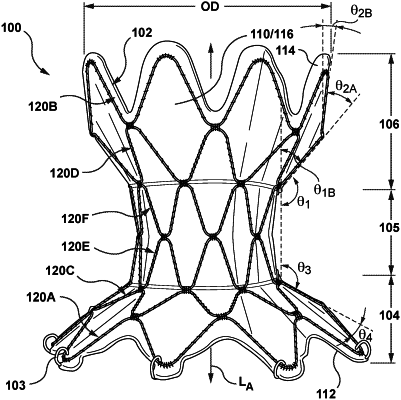| CPC A61F 2/2418 (2013.01) [A61F 2/07 (2013.01); A61F 2002/075 (2013.01); A61F 2/2475 (2013.01); A61F 2/2476 (2020.05); A61F 2210/0014 (2013.01); A61F 2220/0075 (2013.01); A61F 2230/0078 (2013.01); A61F 2250/001 (2013.01); A61F 2250/0018 (2013.01); A61F 2250/0039 (2013.01); A61F 2250/0069 (2013.01); A61F 2250/0098 (2013.01)] | 20 Claims |

|
1. A prosthesis for implantation within a body lumen, the prosthesis having a radially expanded configuration and a radially compressed configuration, the prosthesis comprising:
a tubular graft defining a lumen that extends from an inflow end to an outflow end thereof, wherein a longitudinal axis of the prosthesis is defined by the lumen of the tubular graft;
a prosthetic valve component disposed within the lumen of the tubular graft;
an inflow stent attached to the inflow end of the tubular graft;
an outflow stent attached to the outflow end of the tubular graft; and
a plurality of body stents attached to the tubular graft and disposed between the inflow stent and the outflow stent, a first body stent of the plurality of body stents being disposed directly adjacent to the inflow stent and a second body stent of the plurality of body stents being disposed directly adjacent to the outflow stent,
wherein each of the inflow stent, the outflow stent, and each stent of the plurality of body stents is a sinusoidal patterned radially-expandable ring having a first set of crowns and a second set of crowns, the first set of crowns being disposed closer to the inflow end of the tubular graft than the second set of crowns, and
wherein the second set of crowns of each of the inflow stent and each body stent of the plurality of body stents is disposed against and attached to the first set of crowns of an adjacent stent, and
wherein each of the second body stent and the outflow stent is oriented to extend radially outwards in a direction from the first set of crowns thereof to the second set of crowns thereof, the second body stent being oriented at a first acute angle relative to the longitudinal axis of the prosthesis and the outflow stent being oriented at a second acute angle relative to the longitudinal axis of the prosthesis, the second acute angle being less than the first acute angle.
|